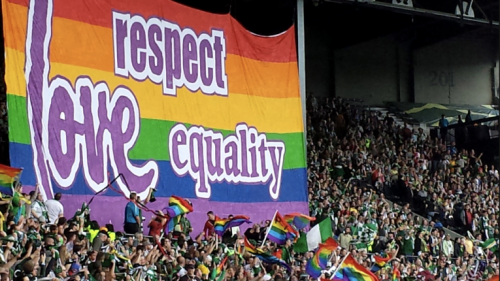
https://www.sportanddev.org/en/article/news/making-sport-more-inclusive-...
Sport is not only a male-dominated field, but also inherently masculine, with overt focus on performance, competition, and excellence. The performance-oriented approach leads to the internalization of certain behaviors and roles which are deemed necessary for one’s survival in sport. Examples of such behaviors include suppression of emotions, normalizing humiliation by peers and coaches, and encouraging aggression or even violence. These behaviors create negative experiences for those participating in sports, who often end up perpetuating these restrictive norms.
Due to the dominance of this hyper-masculine perception of sport, it becomes an exclusive and limited space. Due to this, homophobia is a widely present phenomenon within sports, making it challenging for the LGBTQ+ community to participate in as well as access sports. The burdens and pressures of adhering to gender stereotypes in sports often pushes away members of the LGBTQ+ community to participate. For those who do choose to participate, they usually do not openly express themselves, due to the fear of bullying or exclusion, or are at the receiving end of discrimination.
Discrimination against the LGBTQ+ community in sports
Discrimination against the LGBTQ+ community in sport is rampant, existing in the form of physical and emotional abuse, bullying, threats of violence and peer pressure. A global study found that 80% of the participants believed that the LGBTQ+ community is ‘not at all accepted’ or only ‘accepted a little’ in sports, while 90% of the LGBTQ+ people feel that homophobia and transphobia are major problems in sports. Thus, sport has been an unsafe space for the LGBTQ+ community.
Different stakeholders involved in sports, including coaches, peers, spectators, as well as sport federations, are also responsible for creating a culture of homophobia. Locker rooms and changing rooms often become breeding grounds for the bullying and harassment for the LGBTQ+ persons, which is where peers and mates are involved. Coaches often use homophobic slurs to pressure and humiliate players. Through discriminatory and exclusionary policies, sport academies and federations also tend to add to the barriers to community’s participation in sports.
The transgender community faces the harshest brunt of discrimination, as sport is usually seggregated between men and women. Trans athletes are barred from participating with the gender they associate with, which is a rejection of their identity. At international competitive levels, many federations do not allow trans women to participate in the women’s category, as they are said to have competitive advantage over other participants. Recently, the International Swimming Federation (FINA), voted against trans women’s participation in competitions. Trans inclusion in sport, thus, seems far from reality.
Inclusion of the LGBTQ+ community in sports
The sixth principle of the International Olympics Charter states that rights and freedoms laid out by the Olympic Charter will be secured regardless of the individual’s race, sex, sexual orientation, religion or political opinion. The IOC has also attempted to integrate diversity and inclusion in the planning and delivery of the Olympic Games through the inclusion of sexual orientation in the non-discriminatory clause of the host ciity contract, wherein host cities are bound to abide by the principles and values enshrined by the Charter.
More recently, the IOC replaced its controversial policy on transgender and intersex athletes, which required them to undergo a medical treatment if they did not meet the desired level of testesterone. The updated policy states that athletes will no longer be mandated to undergo ‘unnecessary’ medical surgeries to participate, but are subjected to the guidelines of their sport’s federations.
What more can be done?
While institutional efforts are being made towards including the LGBTQ+ community, these remain insufficient. Here are some recommendations can be taken into consideration to integrate the LGBTQ+ community in sports:
- Policies: Sport federations and other sport-based organizations must have strict policies on respecting the LGBTQ+ community. This can include clauses on anti-bullying, a ban on transphobic and homophobic language, and the provision of equal opportunities for all, including members of the LGBTQ+ community, at all levels of sport.
- Positive masculinity: It is important that everyone, in grassroots and elite sport, challenges the dominant, masculine perceptions of sport. Using sport as a space to share emotions and feelings can be one way of doing that. Sport could also be utilized to challenge gender stereotypes as well, making sport more welcoming for the LGBTQ+ community.
- Making allies: Given the heteronormative world we live in, stakeholders in sport do not usually have LGBTQ+ friendly attitudes, making it necessary to educate and sensitize them on issues pertaining to the community. Parents, peers, coaches and spectators, should be educated on the rights of the LGBTQ+ community, sharing a space with members of the community, using the right language and creating a supportive environment for them.
- Gender-neutral sporting infrastructure: The existing sporting infrastructure is mostly binary and ignores the existence of non-binary and trans identities. Sport-related spaces like stadiums and fields should have gender neutral changing rooms or restrooms.
An inclusive future
This is only a start to what must be done to include the LGBTQ+ community in sports and ensure that sport is a more inclusive place for all marginalized genders. Much more needs to be done, and at a quicker pace, to ensure inclusion and make sport a safe space. In the process of making sport an inclusive space, it is imperative that different voices from the LGBTQ+ community are heard and their recommendations are acted upon.
______________________________________________________________________________
Isha Saxena is a Research Associate at Pro Sport Development.










Add new comment